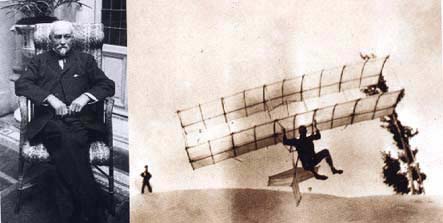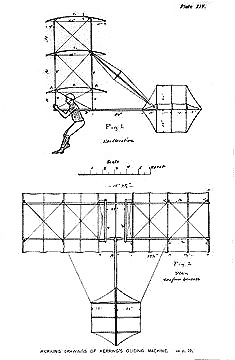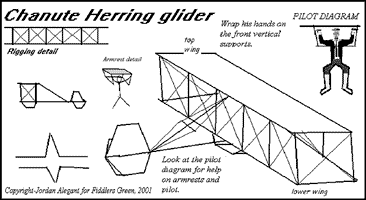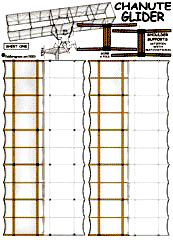
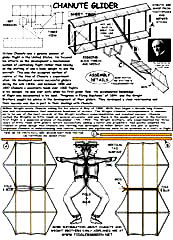
Chanute-Glider - $$3.95
Along with the standard glider flown by Otto Lilienthal of Germany, the Chanute glider, designed by Chanute but also incorporating the ideas of his young employee Herring with regard to automatic stability, was the most influential of all flying machines built before the Wright brothers began designing aircraft.
Octave Chanute and his 1897 'double decker 'hang-glider
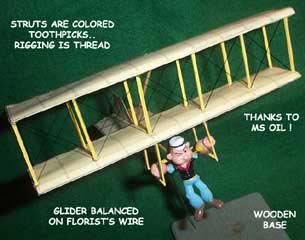
The glider that the Wright brothers referred to as the 'Chanute double decker' was built in July and August of 1896 between two visits that summer to the Indiana dunes. Its trussed bi-plane design would be the model for the Wright brothers in constructing their gliders and eventually their first airplane. This model is from the Fiddlers Green "Centennial of Flight" Series.
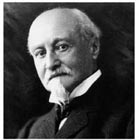 The Most Successful Pre-Wright Glider
The Most Successful Pre-Wright Glider
Octave Chanute and fellow flying enthusiasts went to wind-swept Miller Beach on Lake Michigan in 1896 to test three new glider designs. The type seen here was originally built as a triplane. Early flights revealed to Chanute and his co-designer, Augustus Herring, that the three-winged machine had too much lift-which made it unstable. With the bottom wing removed, it not only outperformed the other designs, but proved at the time to be the most successful glider ever built-with hundreds of controlled flights of up to 359 feet, for as long as 14 seconds. Its rigid, truss supported biplane design became the basis for the Wright brothers' gliders.
Octave Chanute (1832 - 1910):
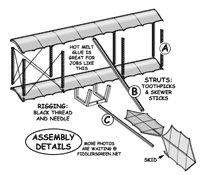 Octave Chanute was a civil engineer, business man and aviation
enthusiast whose standing in the aeronautical world of the time
was well established. In 1894 he had published a compendium of
articles, Progress in Flying Machines, which quickly became the
"bible" to a legion of aviation experimenters. He had
been researching and experimenting since the 1850's, and his library
in Chicago was probably one of the most complete on the subject
of aeronautics in the world.
Octave Chanute was a civil engineer, business man and aviation
enthusiast whose standing in the aeronautical world of the time
was well established. In 1894 he had published a compendium of
articles, Progress in Flying Machines, which quickly became the
"bible" to a legion of aviation experimenters. He had
been researching and experimenting since the 1850's, and his library
in Chicago was probably one of the most complete on the subject
of aeronautics in the world.
Born in Paris in 1832 he emigrated with his father in 1838 and was educated in private schools in New York City. While never having had formal training as an civil engineer, he nevertheless progressed through employment with various railroad companies to become the chief engineer of the Chicago and Alton Railroad in 1863.
After the Civil War he designed and supervised the construction of the first railroad bridge over the Missouri River at Kansas City. In the 1870's and 1880's he served as an engineering consultant to the railroads which were spreading their tracks into the west and spanning rivers with bridges. In 1890 he went into the business of railroad tie preservation, a business that gave him enough financial security to be able to finance experiments in aviation. He was a generous man who shared his knowledge and resources with people who shared his dream of flight.
|
Octave Chanute and the Wright Brothers:
When the Wright brothers first became seriously interested in
the problem of manned flight in 1899 they wrote to the Smithsonian
Institution and requested from it's Secretary everything that
had been written on the subject so far. From the materials they
received back from the Smithsonian it didn't take them long to
realize that Octave Chanute in Chicago had not only become the
intellectual clearinghouse for information about experiments worldwide,
but highly successful experimenter in his own right.
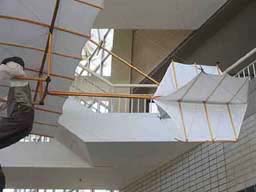 Use these photos to help
create your own 1897 Double decker Chanute Glider. Use these photos to help
create your own 1897 Double decker Chanute Glider. |
Chanute's original was the forerunner of the modern hang-glider. The "pilot" hung by his armpits from the wooden supports beneath the lower wing, throwing his weight from side to side to steer the craft. The aircraft featured Chanute's square-truss design, first employed in railroad bridge construction and later used by the Wright brothers on their 1903 Flyer.
|
|
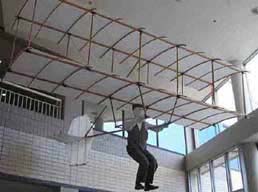 These are photos of the
Chanute Glider hanging up over the entrance lobby at the Boeing
Field Museum of Flight in Seattle, Washington The replica of
Octave Chanute's 1896 biplane glider was built by Paul Dees in
1995-96. ..And EVEN flew it 'briefly and safely' he wrote in
an email (3/03) These are photos of the
Chanute Glider hanging up over the entrance lobby at the Boeing
Field Museum of Flight in Seattle, Washington The replica of
Octave Chanute's 1896 biplane glider was built by Paul Dees in
1995-96. ..And EVEN flew it 'briefly and safely' he wrote in
an email (3/03) |
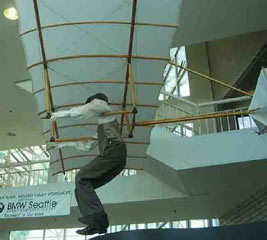 |
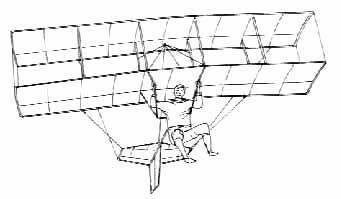
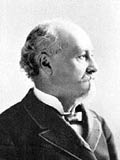 Each year
more than a million people journey to northern Indiana to relax
in the sun and sand and savor the natural beauty of Dune country.
All too few of the visitors to Indiana Dunes National Lakeshore
realize what an important role this area played in the story of
the invention of the airplane. It was here, in the spring and
summer of 1896, that Octave Chanute and four young assistants
helped to set the stage for the achievement of powered flight
with a series of important glider trials. A native of Paris, France,
born on February 18, 1832, Octave Chanute immigrated to the United
States with his father in 1838. Educated in New York schools,
he took his first job in 1844 as a member of a surveying crew
laying out the route of the Hudson River Railroad.
Each year
more than a million people journey to northern Indiana to relax
in the sun and sand and savor the natural beauty of Dune country.
All too few of the visitors to Indiana Dunes National Lakeshore
realize what an important role this area played in the story of
the invention of the airplane. It was here, in the spring and
summer of 1896, that Octave Chanute and four young assistants
helped to set the stage for the achievement of powered flight
with a series of important glider trials. A native of Paris, France,
born on February 18, 1832, Octave Chanute immigrated to the United
States with his father in 1838. Educated in New York schools,
he took his first job in 1844 as a member of a surveying crew
laying out the route of the Hudson River Railroad.
Over the next 30 years he rose to the rank of chief engineer with a number of the most important railroads in the nation. He was responsible for building the first bridge over the Missouri River and supervised the construction of railroads that opened the West to settlement. Virtually every cow driven north from Texas passed through the stockyards Chanute designed for Chicago and Kansas City. His services as a civil leader and urban planner were critical to the development of towns across the West. By 1890, Octave Chanute, now one of the best known and most successful civil engineers in the nation, had established both a consulting practice and a wood preservation firm in Chicago.
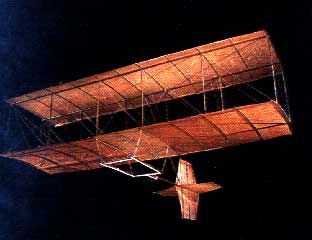 At last he would have some spare time to pursue
his hobby~flying machines. Chanute had been fascinated by the
problem of flight for almost two decades. He had corresponded
with virtually every major aeronautical experimenter in the world
and sponsored discussions of flight at important engineering conferences.
In the process, he had created an informal network of serious
aviation experimenters that would shape the early development
of the technology. The first fruit of his effort was the publication
of Progress in Flying Machines in 1894. One of the most important
books published on aviation up to that time, the volume provided
a remarkably complete record of what had been accomplished in
the past and pointed the way to the future.
At last he would have some spare time to pursue
his hobby~flying machines. Chanute had been fascinated by the
problem of flight for almost two decades. He had corresponded
with virtually every major aeronautical experimenter in the world
and sponsored discussions of flight at important engineering conferences.
In the process, he had created an informal network of serious
aviation experimenters that would shape the early development
of the technology. The first fruit of his effort was the publication
of Progress in Flying Machines in 1894. One of the most important
books published on aviation up to that time, the volume provided
a remarkably complete record of what had been accomplished in
the past and pointed the way to the future.
As early as 1894, inspired by the work of the German glider experimenter Otto Lilienthal, Chanute began to design gliders capable of carrying human beings into the air. Anxious to provide employment for younger engineers and flying machine enthusiasts, he began contracting for the construction of several gliders. He selected the sand dunes along the southern shore of Lake Michigan as the perfect place to test his creations. The area was close to Chicago. The little train station at Miller, Indiana served as an entry point into Dune country. The area offered a number of other important advantages, including steady winds, dunes from which a glider could be launched in any direction, an abundance of sand for soft landings, and, Chanute hoped, relative isolation.
Chanute and his four assistants pitched their tents on a spot within the present city limits of Gary, Indiana, on June 22, 1896. Augustus Herring, the most experienced member of the group, had brought a glider based on the standard Lilienthal monoplane design. William Avery, a Chicago carpenter, had constructed a multi-wing glider designed by Chanute, while William Butusov would attempt to launch his own glider, the Albatross, down a wooden ramp. Dr. James Ricketts, a Chicago physician with "a slack practice and a taste for aeronautics," would cook for the group and provide emergency medical service as required. Chanute's dogs, Rags and Tatters, rounded out the party.
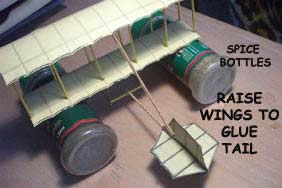 Herring
and Avery did most of the flying. The Lilienthal glider proved
to be a disappointment. Chanute's glider, featuring multiple sets
of wings that could be arranged in various configurations, was
more interesting, covering distances of from 50-116 feet through
the air. The group returned to Chicago on July 4. They would spend
the next month repairing their various craft and building a new
glider featuring three wings set one on top of the other, all
linked together with a truss of the sort that Chanute had employed
in constructing railroad bridges. Herring was apparently responsible
for the cruciform tail.
Herring
and Avery did most of the flying. The Lilienthal glider proved
to be a disappointment. Chanute's glider, featuring multiple sets
of wings that could be arranged in various configurations, was
more interesting, covering distances of from 50-116 feet through
the air. The group returned to Chicago on July 4. They would spend
the next month repairing their various craft and building a new
glider featuring three wings set one on top of the other, all
linked together with a truss of the sort that Chanute had employed
in constructing railroad bridges. Herring was apparently responsible
for the cruciform tail.
The five men returned to the Dunes on August 21, 1896, establishing a new camp some five miles down the beach from their original site. After some disappointing test flights, Chanute ordered the bottom wing removed from the new glider, producing a biplane design. With that modification complete, Herring and Avery were soon making repeated flights of over 200 feet in length, occasionally traveling as far as 350 feet through the air. By the time the group broke camp for good on September 25, 1896, they had completed several hundred flights with the biplane. For the moment, the little craft was the most successful heavier-than-air flying machine in the world.
The 1896 biplane tested on the Indiana Dunes proved to be a key step on the road to the invention of the airplane. Herring continued to experiment with the design on his own over the next five years. Chanute's publication of the plans and specifications for the glider helped to spark a renewed interest in flight both in America and Europe. In May 1900, Octave Chanute received a letter from Wilbur Wright. "Afflicted with the belief that flight is possible to man," the Wrights had designed a glider of their own. "In appearance, Wilbur noted, "it is very similar to the 'double-decker machine with which the experiments of yourself and Mr. Herring were conducted in 1896-97."
Jordan Alegant sent
us a model of the Chanute glider back in 2001 He was still in middle school and the model wasn't quite up to FG standards but the instructions were pretty neat and we include them here.. Thanks Jordan !!! |
The letter marked the beginning of an association that would continue
until Chanute's death in November 1910. During the years 1900-1905,
when the genius of the Wright brothers carried them far beyond
any of their predecessors to the ultimate goal of the invention
of the airplane, Chanute was their closest friend and most important
supporter. While disagreements drove the three men apart after
1905, the Wrights never forgot how important the friendship and
inspiration of Octave Chanute had been to them during the early
years.
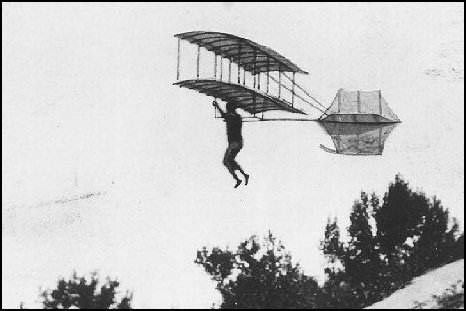
"His labors had vast influence in bringing about the era of human flight," Wilbur Wright observed at the time of Chanute's death. "No one was too humble to receive a share of his time. In patience and goodness of heart he has rarely been surpassed. Few men were more universally respected and loved."
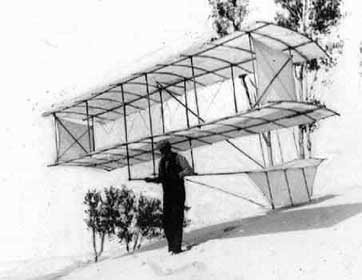 Modern
visitors to Indiana Dunes National Lakeshore and Indiana Dunes
State Park will find little to remind them of the significance
of the area to the history of flight. The dune from which the
Chanute party conducted their first experiments Untie 22-july
4, 1896) stood within the present city limits of Gary, Indiana,
northeast of the Lake Street Bridge and west of the refurbished
Aquatorium building. Streets and buildings cover the actual site
of the dune, but the spot is commemorated with a plaque. A National
Soaring Society historic marker is located in front of the Aquatorium.
Current plans call for the installation of exhibits on Chanute
and on the Tuskeegee Airmen of World War 11 in this building.
Modern
visitors to Indiana Dunes National Lakeshore and Indiana Dunes
State Park will find little to remind them of the significance
of the area to the history of flight. The dune from which the
Chanute party conducted their first experiments Untie 22-july
4, 1896) stood within the present city limits of Gary, Indiana,
northeast of the Lake Street Bridge and west of the refurbished
Aquatorium building. Streets and buildings cover the actual site
of the dune, but the spot is commemorated with a plaque. A National
Soaring Society historic marker is located in front of the Aquatorium.
Current plans call for the installation of exhibits on Chanute
and on the Tuskeegee Airmen of World War 11 in this building.
There is nothing to identify the site of Dune Park, where the second round of flight tests were conducted (August 21-September 26, 1896). The area is some five miles east of the Miller Beach site, where, Chanute noted: "the hills were higher, the solitude greater, and the path ... more obscure." The historic dunes from which the first Chanute-Herring biplane was flown is now covered by the remains of a Midwest steel plant.
Written by Tom D. Crouch, Ph.D.,- Senior Curator of Aeronautics, National Air and Space Museum- Smithsonian Institution.



